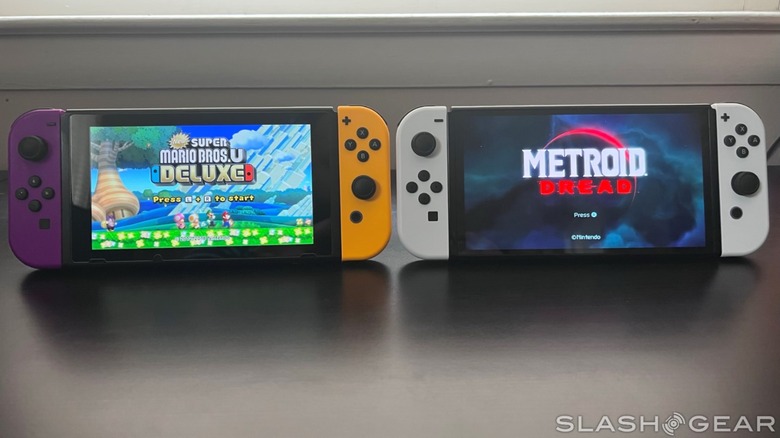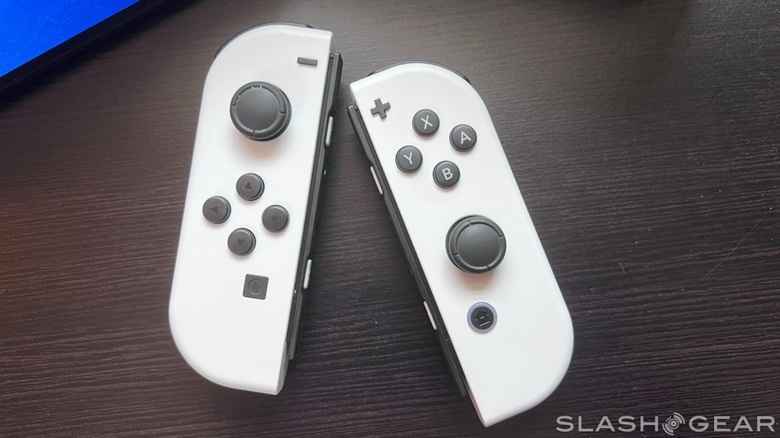Nintendo Switch OLED Review
- Beautiful, larger OLED display
- Improved dock with a built-in LAN port
- Better audio in handheld mode
- A massively upgraded kickstand
- Not worth the upgrade for current Switch owners
- No performance improvements
It's safe to say that the Switch OLED is not what most people had in mind when it became clear that Nintendo was revealing a new Switch model. After rumors of a 4K Switch took hold, the Switch OLED was probably doomed to never live up to the hype, but still, most of us were expecting a more significant upgrade than this. Yet, the Switch OLED arrived anyway, and with somewhere in the area of 90 million consoles sold already, the big question has to be whether or not it's worth upgrading for current Switch owners.
The answer, unfortunately, is a firm no – in most cases, at least. That isn't to say that the Switch OLED is a bad console – in fact, if you're in the market for your first Switch, this is probably the one you want to go for. But for current Switch owners, there's so little here to warrant an upgrade.
Whether or not you decide to upgrade ultimately depends on how much of a handheld enthusiast you are. Do you play games mostly (or even exclusively) in handheld mode? Do you want those games to look as good as they possibly can even though actual graphics fidelity won't be getting a boost? If so, then maybe an upgrade is worth it.

It might feel like I'm being pretty negative about the Switch OLED, but I actually like the console a lot. I'm always a big fan of diminishing bezels, for starters, and the Switch OLED definitely has those. The thick borders surrounding the standard Switch's 6.2-inch display have shrunk considerably, leaving us with a 7-inch display that fits in a console that's more or less the same size as its predecessor (though ever-so-slightly longer and heavier).
You wouldn't think that makes a big difference, but it does. Not only is the screen bigger, but it's more colorful and offers better picture quality since it's an OLED panel. The display on the Switch OLED is beautiful, and as someone who has gravitated more toward playing the Switch on a TV as the novelty of a portable console has worn off, the Switch OLED makes me want to go back to playing primarily in handheld mode.

Certain aspects of the Switch have been improved as well, though functionally, they aren't game-changers. The kickstand that spans the entire back of the Switch OLED is a huge improvement over the flimsy stand we get on the standard Switch, and even though that is exciting, I have to wonder how many tabletop mode fans there are who will truly put this new kickstand to good use. Perhaps there'll be more now that the kickstand seems reliable? In any case, the stand can also open further for a variety of different viewing angles, and that's nice to see. After all, it doesn't hurt to have options, even if those options may rarely be used in the grand scheme.
One area where the Switch improves on its predecessor is in its onboard speakers. Nintendo touts that the speakers have been improved for better sound while the Switch OLED is used in tabletop or handheld mode, and to my ear, they do indeed sound better. The Switch OLED can get surprisingly loud, though it seemed to achieve that volume without sounding tinny or becoming distorted in the games I tested.

The Switch OLED can get so loud that it's hard for me to imagine anyone using it at max volume in handheld mode. However, I suppose it could be useful for tabletop mode when the players presumably sit further away from the console. Either way, the dual speakers on the Switch OLED do the job well.
The Switch OLED also comes with a redesigned dock that not only looks better than the original Switch dock, but has increased functionality thanks to the built-in LAN port. Sadly, we lost the inner USB port to accommodate the LAN port, but I can't remember the last time I used that USB port for anything other than the LAN adapter on the standard dock anyway.

The new dock is nice, with a backplate that detaches completely for easier access to its internal port. It works with both the Switch OLED and the standard Switch (as does the original dock), so if you live in a multi-Switch household, it can be used without worry of compatibility issues. All in all, I have no complaints about the dock, though it is a little ridiculous that we had to wait until 2021 to get an integrated LAN port. Think of all the laggy Super Smash Bros. Ultimate matches that could have been avoided if the original Switch dock included a LAN port to begin with!
As far as performance goes, you're not going to find any differences between the Switch OLED and the standard Switch. Internals haven't been upgraded in any meaningful way, so games will run the same and continue to display at a max of 720p in handheld mode. Even battery life is very similar between the two models, with the Switch OLED lasting just as long as the HAC-001(-01) model that was introduced in 2019 in my testing. Finally, I should note the impressive standby battery life of the console; even after a day in sleep mode, the battery's charge only decreased by a few percentage points for me.
Nintendo Switch OLED verdict
So, at the end of it all, we're left feeling like the Switch family is now a little too crowded. When the Switch OLED was first announced, I wrote an article arguing that it should be the new standard Switch model, and after using it, I still think that's true. Perhaps it isn't the new standard because Nintendo doesn't want to sell the OLED model at a $300 price point, but the alternative is that now we have two Switch models that are very close to one another in terms of functionality, performance, and pricing, only one has an objectively worse display and dock.

If you're one of the seven people who have yet to buy a Nintendo Switch and you're finally ready to dive in, get the OLED model. Everyone else who owns a standard Switch probably doesn't need to upgrade unless you're some kind of super enthusiast for whom money is not an issue. Before the Switch OLED launched, everyone said it wouldn't be worth an upgrade, and now that it's here, that analysis has held true. If, however, you only own a Switch Lite and you regret sacrificing TV mode to save some money, this upgrade becomes a little more appealing.
Don't get me wrong; the Switch OLED is a good console – it's the best Switch available at the moment, no question. But with nearly 100 million Switch consoles sold already, its existence is a bit of a head-scratcher. It doesn't give current Switch owners much reason to upgrade, and I can't help but wonder if the decision to keep the standard Switch around will cannibalize OLED sales by way of mainstream families who compare price tags, assume there are no major differences (a correct assumption), and decide to save $50.

It's a weird state of affairs, to be sure. That said, while the Switch OLED makes for a poor upgrade, it will be an excellent purchase for first-time buyers. If you have the extra $50 to spare and you're trying to decide which model to go with, take the plunge and grab the OLED model. Your eyes, tabletops, and Smash Bros. opponents will thank you later.
